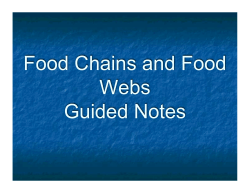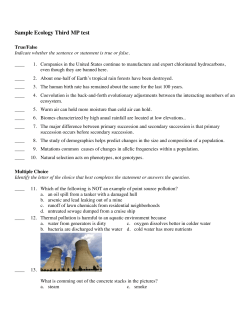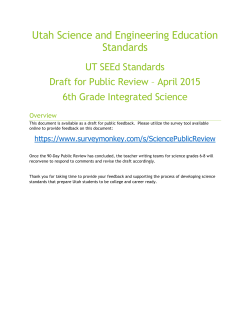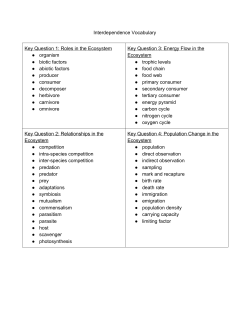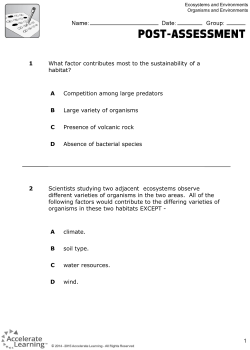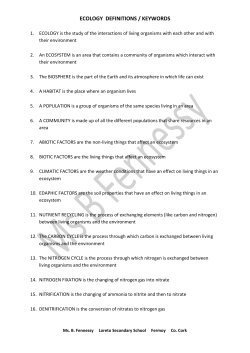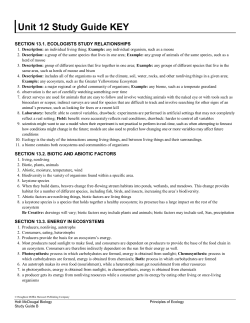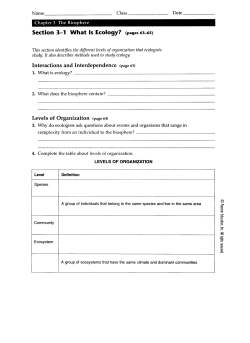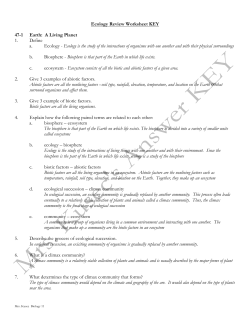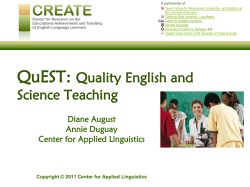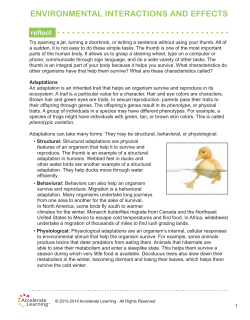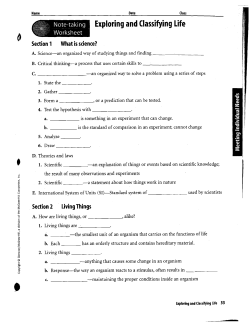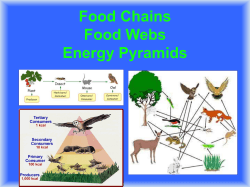
Interactions and Ecosystems Grade 7 Science Ms. Lyons
Interactions and Ecosystems Grade 7 Science Ms. Lyons Topic 1: Interactions Within Ecosystems • Ecology: The study of the relationships between living organisms and their environment. • Scientists who study these relationships are called ecologists. The Needs of Living Things • All living things from spiders, to 1) 2) 3) 4) sunflowers, to humans need… Food Water Habitat Air (gas exchange) Adaptation • Adaptation: is an inherited characteristic that helps an organism survive and reproduce in its environment. • E.g. A duck has webbed feet so it can swim well • E.g. Many birds have hollow bones so they can fly easily. Continued… • There are however many characteristics that help animals survive in their environment that are learned. • E.g. Humans learn to look both ways before crossing the street. • These however, are not adaptations. Ecosystems • An ecosystem is the interactions between living and non-living things in a particular environment. • E.g. A rotting log is an example of an ecosystem. The organisms living in and on the log and the soil, temperature, and other non-living features around the log are interacting. Interactions Between Living Things in an Ecosystem • Symbiosis: Occurs when two species live closely together in a relationship that lasts over time. • Can you think of any examples?? 3 Types of Symbiosis • Mutualism: Each partner benefits from the relationship! • e.g. The remora fish uses suckers on its head to • attach itself to a shark. It then eats the bacteria living on the shark’s skin. Other examples?? Continued… • Parasitism: One partner benefits from the relationship and the other is harmed. • Which is which?? Parasite or host?? Examples: tapeworm, mosquito, leech Continued… • Commensalism: One partner benefits and the other appears to be unaffected • The orchid plant lives high up attached to the trunks of trees. The orchid benefits by having a safe place to live, the tree does not benefit or suffer. • Other Examples??? Impacts on Ecosystems • Relationships exist between the living and non-living. These can have a major impact on an environment. • The beaver can have a dramatic impact on water and • change the environment around them by building dams. Other examples?? Topic 2: Human Impacts on Ecosystems • Humans have a more dramatic and often more devastating effect on the Earth’s ecosystems than any other animal. Natural Resources • We rely on the ecosystem around us, just like all living things do. We use natural resources to meet our basic needs. • Natural Resources: The materials and products that are found in nature. • Examples??? People and Nature: A Changing Relationship • How have the ways people interact with the environment changed over time?? • Gathering Food in Alberta Buffalo Hunt → Small Farms → Feedlots How has this affected the environment?? Other Examples?? Needs vs. Wants • Need: Something you need to survive • Want: Things that make our lives more enjoyable Topic 3: Environmental Choices • Ecological Footprint: Is a calculation of the total area of land and water needed to supply all of the materials and energy that you use as well as absorb all of the waste you produce. • What does that mean?? Sustainability • Sustainability: A system where the resources are being renewed as quickly as they are being used. All wastes are able to be completely absorbed. Ways to Help the Environment • The 3 R’s: • Reduce: The amount of garbage you produce • Reuse: Products rather than throwing them away • Recycle: Find other ways to make use of products if they cannot be reused. Topic 4: How Organisms Interact • There are both living and non-living parts of an ecosystem. • Biotic: living parts of the ecosystem • Abiotic: non-living parts of the ecosystem (have never been living). • Examples?? The Roles of Organisms in an Ecosystem • Niche: The role of an organism in its ecosystem. • To determine an organism’s niche, you must look at what it eats, where it lives, and how it interacts with other organisms in its ecosystem. Types of Niches… • Producers: make food for themselves using the sun’s energy through a process called photosynthesis. • Examples??? • Producers make life possible for all other organisms on Earth. Continued… • Consumers: Consumers eat the food made by producers. Consumers can eat producers or other consumers. • Herbivores: Eat producers only and fill the plant-eating • • • niche. E.g. cows, deer, horses… Carnivores: Eat other consumers and fill the meateating niche. E.g. wolves, coyotes, sharks… Predators: Kill and eat other animals (cougar) Prey: Get killed an eaten by predators (mouse) Continued… • Omnivores: Eat both producers and consumers. E.g. raccoons, skunks and humans • Food Chain: is a model that shows how the energy stored in food is passed from organism to organism. Food Webs • Food Webs: Are more complex than food chains. They show all of the relationships between predator and prey in an ecosystem. (They are a combination of several food chains) Pyramid of Numbers • Food Chains and Food Webs show how food energy moves throughout a system but not how many organisms it involves. To solve this, scientists invented the pyramid of numbers. • Biomass: The total mass of all the organisms in an ecosystem The Order of Consumers • There are Primary, Secondary and Tertiary Consumers. Explain… The Clean-up Squad • Scavengers: Are organisms that feed on dead or • decaying plant and animal matter. Examples?? • Decomposers: Don’t actually eat dead material, instead • they grow on or in dead material, absorbing some nutrients into their own cells. Examples?? Topic 5: Cycles in the Environment • The Carbon Cycle The Water Cycle Parts of the Water Cycle • Evaporation: is the process in which a liquid changes • • • • • into water vapor. Transpiration: is the process in which water that is taken in through plants roots evaporates from the plant’s leaves, stems and flowers Condensation: is the process in which water vapor changes into liquid. Precipitation: is the process in which liquid water forms from condensation inside clouds and falls as rain, sleet, snow and hail. Ground Water: is water in the soil. Plant roots can grow down to reach ground water. Run-off: Is water that runs off the ground into lakes, rivers or streams. Pollution in the Environment • Pollution: occurs when a substance is added to the environment at such a fast rate that it cannot be broken down, stored or recycled in the air, land or water in a non-damaging form. • Acid Rain: occurs when pollutants containing sulfur and nitrogen are found in high levels in the air. Movement of Pollution • Chemicals can take a very long time to breakdown causing a great deal of damage to plants and animals. • Bioaccumulation: When pollutants move from level to level in the food chain. Topic 6: Succession and Change in an Ecosystem. • Have you ever noticed grasses or plant growing in • • • vacant lot near your home? How does this process happen? Succession: the gradual process by which some species replace others in an ecosystem. Primary Succession: The gradual growth of organisms in an area that was bare, such as rock. E.g. Ferns and mosses growing on rocks Primary Succession Secondary Succession • Secondary Succession: The gradual growth of organisms in an area that previously had a number of organisms. E.g. A burnt forest area Biological Control • Biological Control: Controlling pests using their natural • • • • • enemies. Examples?? Introduced Species: When exotic species are introduced into an environment. They often have no natural enemies and survive and reproduce better than naturally occurring species. They can take over an ecosystem. E.g. Zebra mussel, Purple Loosestrife, Scotch Broom Extinction: When a species no longer exists. Topic 7: Environmental Monitoring • Ecosystem Monitoring (also called Environmental • • • • Monitoring): Is a way to check the condition of an ecosystem by comparing the results of investigations done at different times. Physical Monitoring: Uses satellites to track changes in landscape over time. Environmental Monitoring: Tracks changes in climate, temperature and weather patterns. Chemical Monitoring: Assesses air, soil and water quality. Biological Monitoring: Tracks changes in organisms and populations of organisms over time. Long-Term Monitoring • Indicator Species: A species that is sensitive to environmental change and is the first to be affected; they help to monitor the overall health of our environment. • What would be some good indicator species?? Continued… • Baseline Data: A starting point of data that • allows scientists to go back and see if changes have occurred. Permanent Plots: Study areas that scientists always return to. • A report that outlines how an activity will affect the environment is called an environmental impact assessment.
© Copyright 2024
